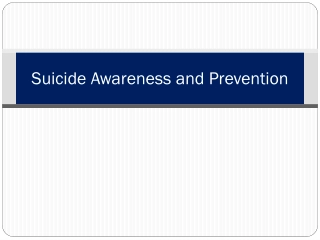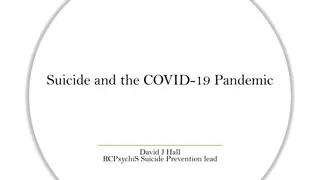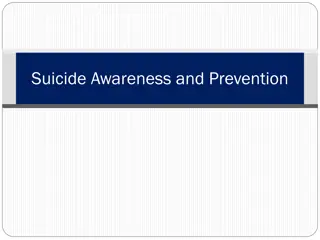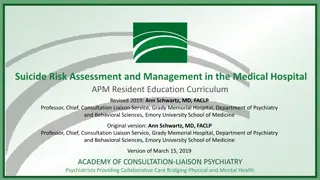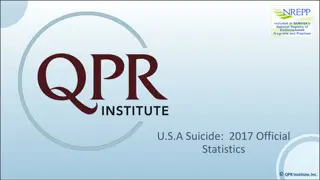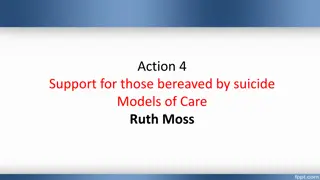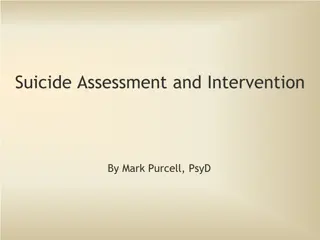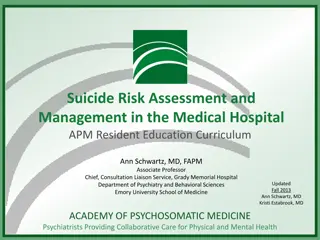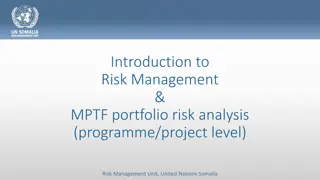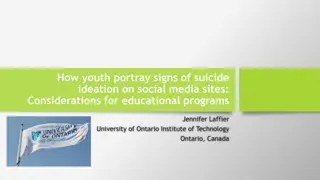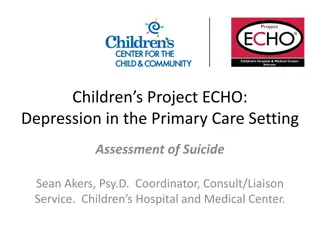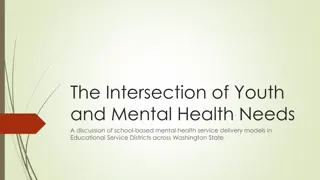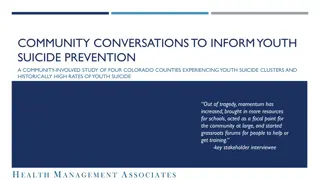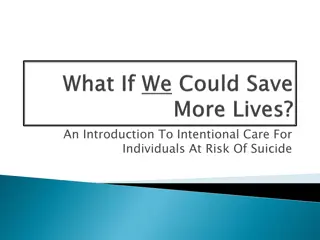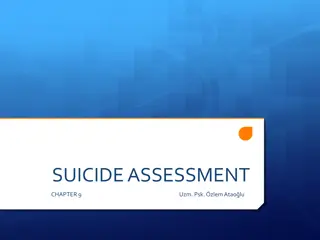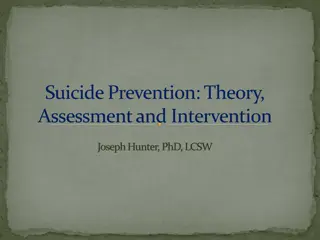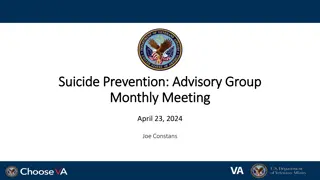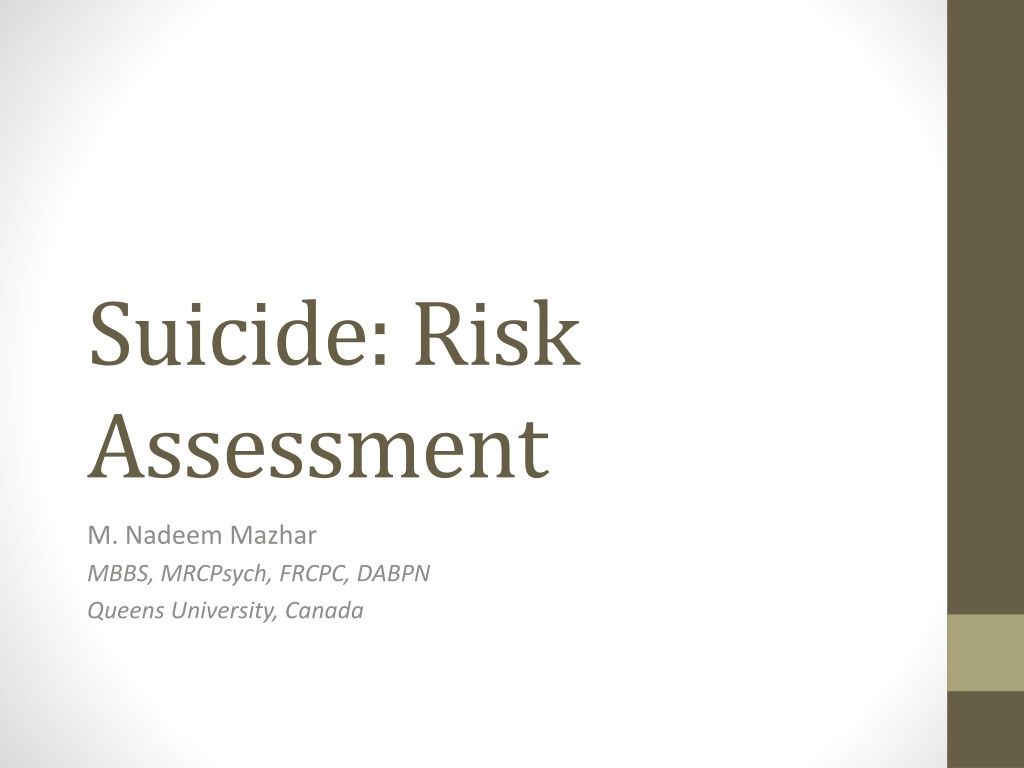
Suicide Risk Assessment and Management in Psychiatry
Explore the definitions, risk factors, and protective factors associated with suicide, along with the importance of suicide risk assessment in psychiatry. Learn about the core competencies required to assess and manage patients at risk of suicide, including recognizing suicidal ideation, behavior, and intent. Discover the demographic factors, cultural beliefs, and environmental influences that contribute to suicide risk, as well as strategies for effectively managing and supporting individuals experiencing suicidal thoughts.
Download Presentation

Please find below an Image/Link to download the presentation.
The content on the website is provided AS IS for your information and personal use only. It may not be sold, licensed, or shared on other websites without obtaining consent from the author. If you encounter any issues during the download, it is possible that the publisher has removed the file from their server.
You are allowed to download the files provided on this website for personal or commercial use, subject to the condition that they are used lawfully. All files are the property of their respective owners.
The content on the website is provided AS IS for your information and personal use only. It may not be sold, licensed, or shared on other websites without obtaining consent from the author.
E N D
Presentation Transcript
Suicide: Risk Assessment M. Nadeem Mazhar MBBS, MRCPsych, FRCPC, DABPN Queens University, Canada
Objectives Study definitions and demographic factors associated with suicide Assess suicide risk factors and protective factors Review management of suicidal patient
Suicide-Importance in Psychiatry Suicide risk assessment is a core competency that psychiatrists are expected to acquire Most common cause of malpractice suits for psychiatrists in U.S.A. Patient suicides are among the most traumatic events in a psychiatrist s professional life
Suicide-definitions Suicide: Self inflicted death with evidence (either explicit or implicit) that the person intended to die Suicidal ideation: Thoughts of engaging in behavior intended to end one s life Suicide plan: Formulation of a specific method through which one intends to die Suicide attempt: Engagement in potentially self-injurious behavior in which there is at least some intent to die Suicidal intent: Subjective expectation and desire for a self destructive act to end in death Deliberate self harm: Willful self-inflicting of painful, destructive or injurious acts without intent to die
Risk Factors Family history of suicide Family history of child maltreatment Previous suicide attempt(s) History of mental disorders, particularly clinical depression History of alcohol and substance abuse Feelings of hopelessness Impulsive or aggressive tendencies
Risk Factors Cultural and religious beliefs (e.g., belief that suicide is noble resolution of a personal dilemma) Local epidemics of suicide Isolation, a feeling of being cut off from other people Barriers to accessing mental health treatment Loss (relational, social, work, or financial) Physical illness Easy access to lethal methods Unwillingness to seek help because of the stigma attached to mental health and substance abuse disorders or to suicidal thoughts
Suicide-protective factors Children in the home Sense of responsibility to the family Pregnancy Religiosity Life satisfaction Reality testing ability Positive coping skills Positive problem solving skills Positive social support Positive therapeutic relationships (APA Practice Guidelines for Assessment and Treatment of Patients with Suicidal Behaviors)
ASSESSMENT AND MANAGEMENT OF SUICIDAL PATIENT
Indications of suicide risk assessment ER or crisis evaluations Intake evaluation Before change in observation status or treatment setting Gradual worsening despite treatment Significant psychosocial stressor Onset of a physical illness (APA Practice Guidelines for Assessment and Treatment of Patients with Suicidal Behaviors)
Suicide risk assessment Collateral information Identify psychiatric signs and symptoms Past suicidal behavior Past treatment history Family history Current psychosocial stressors Psychological strengths and vulnerabilities Current suicidal ideation Low predictive value of actuarial scales
Management of suicidal behavior Establishing therapeutic alliance Determining the appropriate treatment setting Interventions to reduce risk
Admission generally indicated After a suicide attempt if: Patient is psychotic Attempt was violent or premeditated Precautions were taken to avoid discovery Persistent plan/intent is present Increased distress or patient regrets surviving Patient is male, older than age 45 years, especially with new onset of psychiatric illness or suicidal thinking Limited family and social support Current impulsive behavior, severe agitation & poor judgment (APA Practice Guidelines for Assessment and Treatment of Patients with Suicidal Behaviors)
Admission generally indicated In the presence of suicidal ideation with: Specific plan with high lethality High suicidal intent (APA Practice Guidelines for Assessment and Treatment of Patients with Suicidal Behaviors)
Substantive criteria for involuntary admission Varies according to jurisdiction Mentally ill Dangerous to self or others Unable to provide for basic needs
Possible release from ED with follow up After suicide attempt is a reaction to a precipitating event if patient s view of situation has changed Method have low lethality Stable and supportive living situation Patient able to cooperate with recommendations for follow up (APA Practice Guidelines for Assessment and Treatment of Patients with Suicidal Behaviors)
Outpatient treatment may be preferable Chronic suicidal ideation without prior medically serious attempts with safe/supportive living situation and ongoing psychiatric follow up (APA Practice Guidelines for Assessment and Treatment of Patients with Suicidal Behaviors)
Examples of treatable risk factors Depression Anxiety/panic attacks Psychosis Insomnia Substance abuse Impulsivity Agitation Situation (e.g. family, work) Lethal means (e.g. guns, drugs)
Role of medications Antidepressants Lithium Clozapine Antianxiety agents ECT (APA Practice Guidelines for Assessment and Treatment of Patients with Suicidal Behaviors)
Psychotherapies Dialectical behavior therapy Cognitive behavior therapy Interpersonal therapy Psychodynamic therapy
Suicide-risk management Not much evidence for suicide prevention or no harm contracts Increase frequency of contact Ongoing treatment of psychiatric disorders/substance abuse Communication with significant others
Gun safety management Inquire about guns at home Designate a willing responsible person to remove guns Direct contact with designated person confirming removal Do not discharge suicidal patient till confirmation
Suicide risk documentation Risk assessment including documentation of risk/protective factors Record of decision making process Record of communication with other clinicians and family members Medical records of previous treatment Address firearms Consultation in difficult cases
Management of suicide Ensure victim s records are complete Communication with family Support from senior colleagues Consultation with risk manager
References American Psychiatric Association Practice guideline for the Assessment and Treatment of Patients with Suicidal Behaviors (Nov.2003) Riba M., Ravindranath D. (2010). Clinical Manual of Emergency Psychiatry. Washington DC: American Psychiatric Publishing Inc. Runeson B et al. Method of attempted suicide as predictor of subsequent successful suicide: national long term cohort study. BMJ 2010;340: c3222 Simon R. (2011). Preventing Patient Suicide- Clinical Assessment and Management. Washington DC: American Psychiatric Publishing Inc. Statistics Canada website accessed on May 12, 2012

